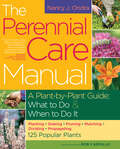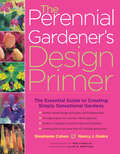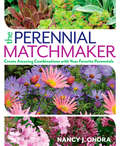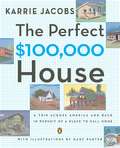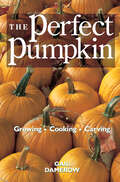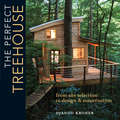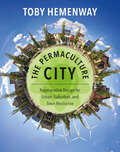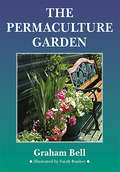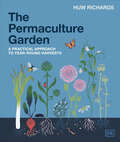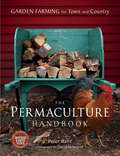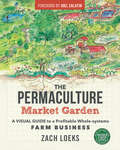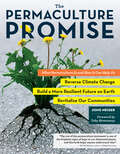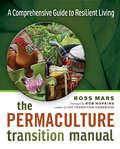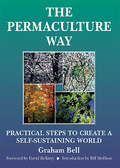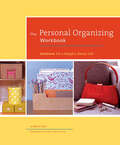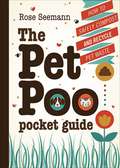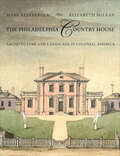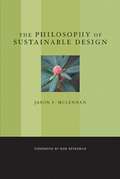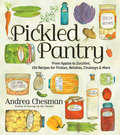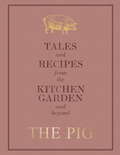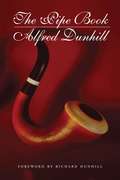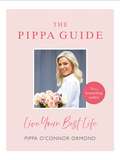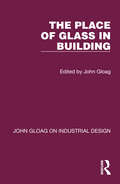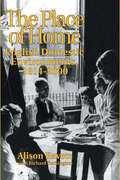- Table View
- List View
The Perennial Care Manual: A Plant-by-Plant Guide: What to Do & When to Do It
by Nancy J. Ondra Rob CardilloKeep your perennial beds looking their best, season after season. From planning and planting to pruning and propagating, this comprehensive guide covers everything you need to know to maintain a stunning perennial garden. Nancy J. Ondra provides an in-depth, plant-by-plant guide that profiles 125 popular perennials, with helpful information on each plant’s soil, light, and water needs. Ondra’s expertise and passion for gardening, along with Rob Cardillo’s breathtaking photography, will inspire you to create a garden of your dreams that will last a lifetime.
The Perennial Gardener's Design Primer: The Essential Guide To Creating Simply Sensational Gardens
by Stephanie Cohen Nancy J. OndraTurn your outdoor landscape into a rich, living canvas of color and texture. Encouraging experimentation, Stephanie Cohen and Nancy J. Ondra show you how to plan a garden that incorporates unique combinations of plants to achieve stunning effects. With an overview of garden design fundamentals and 20 sample garden plans, Cohen and Ondra will inspire you to play with creative juxtapositions of vibrant hues and subtle textures. Let your imagination run wild as you create your own unique and original garden designs.
The Perennial Matchmaker: Create Amazing Combinations with Your Favorite Perennials
by Nancy J. OndraWant foolproof ideas for pairing favorite perennials with an array of harmonious plant partners but don’t know where to start? Plantswoman Nancy J. Ondra helps you to jump-start your perennial garden with her one-plant-at-a-time approach for choosing plant partners. Having spent more than 30 years growing and experimenting with perennials and plant combinations, Ondra shares her extensive experience in this in-depth guide to eye-catching color combinations, dramatic textural displays, and stunning seasonal effects.The Perennial Matchmaker features 80 individual perennial profiles, close to 400 exquisite photographs of plant partnerships, and Ondra’s insight into the wide array of plants that make great combinations, including annuals, bulbs, grasses, shrubs, and other perennials. Each plant profile gives dozens of ideas and suggestions for pairings, including region-specific choices, Ondra’s top-choice perfect match, and an at-a-glance summary of the best color partners.Whether you are just dreaming of your first perennial garden or are a long-time gardener who wants to elevate plantings for a more cohesive and exciting look, The Perennial Matchmaker is your go-to guide for creating stunning plant medleys.
The Perfect $100,000 House
by Karrie JacobsFor anyone who obsessively scours the real estate section and dreams of purchasing or building a house, The Perfect $100,000 House is a beacon of hope. Founding editor in chief of Dwell magazine and noted architecture and design critic Karrie Jacobs decided to see for herself whether it was still possible in America's overheated real estate market to build a home of one's own for a reasonable sum. Her quest took her across the country, where she encountered creative solutions to the housing dilemma, as well as visionary architects and builders revolutionizing how Americans think about homes, construction, and community.
The Perfect Pumpkin: Growing/Cooking/Carving
by Gail DamerowThe big orange pumpkin is no longer just for Halloween! Gail Damerow shows you how to cultivate more than 95 varieties of pumpkin, and provides recipes for pumpkin pies, muffins, and even pumpkin beer. You’ll also learn how to use pumpkins in a variety of craft projects, from carving unique jack-o’-lanterns to creating pumpkin-scented creams and soaps. With tips on growing giant pumpkins, preserving your harvest through the winter, and much more, The Perfect Pumpkin will delight pumpkin lovers of all sensibilities.
The Perfect Treehouse: From Site Selection to Design & Construction
by Django KronerTreehouses speak to the little kid in each of us. Who doesn't love the idea of a fantasy house in the treetops? But building a treehouse the right way takes a lot of thought, planning and hard work. This book is here to help you dream big yet approach your treehouse build in an achievable way. You'll learn:Everything you need to know in order to choose a suitable location and the right materials for your buildHow to choose the right treeWhich tools you need and how to use themHow to build with the health of the tree in mind - which is important for treehouse safety as well as the environmentIn addition to plenty of inspiration for making a home in the canopy, you'll find professional advice on materials, best practices and tree selection. More than just an aspirational book, "The Perfect Treehouse" is your guide to making your dream treehouse a reality.
The Permaculture City: Regenerative Design for Urban, Suburban, and Town Resilience
by Toby HemenwayPermaculture is more than just the latest buzzword; it offers positive solutions for many of the environmental and social challenges confronting us. And nowhere are those remedies more needed and desired than in our cities.The Permaculture City provides a new way of thinking about urban living, with practical examples for creating abundant food, energy security, close-knit communities, local and meaningful livelihoods, and sustainable policies in our cities and towns. The same nature-based approach that works so beautifully for growing food—connecting the pieces of the landscape together in harmonious ways—applies perfectly to many of our other needs. Toby Hemenway, one of the leading practitioners and teachers of permaculture design, illuminates a new way forward through examples of edge-pushing innovations, along with a deeply holistic conceptual framework for our cities, towns, and suburbs.The Permaculture City begins in the garden but takes what we have learned there and applies it to a much broader range of human experience; we&’re not just gardening plants but people, neighborhoods, and even cultures. Hemenway lays out how permaculture design can help towndwellers solve the challenges of meeting our needs for food, water, shelter, energy, community, and livelihood in sustainable, resilient ways. Readers will find new information on designing the urban home garden and strategies for gardening in community, rethinking our water and energy systems, learning the difference between a &“job&” and a &“livelihood,&” and the importance of placemaking and an empowered community.This important book documents the rise of a new sophistication, depth, and diversity in the approaches and thinking of permaculture designers and practitioners. Understanding nature can do more than improve how we grow, make, or consume things; it can also teach us how to cooperate, make decisions, and arrive at good solutions.
The Permaculture Garden
by Graham BellWorking entirely in harmony with nature, The Permaculture Garden shows you how to turn a bare plot into a beautiful and productive garden. Learn how to plan your garden for easy access and minimum labor; save time and effort digging and weeding; recycle materials to save money; plan crop successions for year-round harvests; save energy and harvest water; and garden without chemicals by building up your soil and planting in beneficial communities. Full of practical ideas, this perennial classic, first published in 1995, is guaranteed to inspire, inform, and entertain.
The Permaculture Garden: A Practical Approach to Year-Round Harvests
by Huw RichardsHarvest year-round from your bountiful and sustainable fruit and vegetable garden.Huw Richards’ ultimate guide to permaculture gardening, outlining the regenerative methods that make gardening easier to do while being more productive. Huw shows you how to expand your growing beyond annual staples like tomatoes and cabbage to perennial fruits and vegetables, berry bushes, and fruit trees. By mixing your planting, gardening with the seasons, and optimizing your garden design, you will create a more beautiful and more sustainable garden that is better for the soil, local wildlife, and your crops – without costing more of your time.The book includes:What to grow: a substantial and comprehensive reference of all the edible plants and flowers you can grow – when to sow, grow, and harvest.Includes perennials that produce every year, maximizing yield for effort as well as introducing new plants to your garden.A permaculture approach: streamline the way your garden operates with ideas on building resilience (for example, how to store water), using vertical space, generating healthy soil, and mixed “polyculture” planting.Aesthetics and environment: how to make your kitchen garden look good year-round by planting ornamental edibles and flowering crops that attract pollinators.Maximizing space: a chapter on spaces helps you grow in shade or a south-facing corner and use pots and climbing varieties up walls and fences to bolster beds and under-cover growing areas. A roadmap for the year ahead guides you through the key moments throughout the four seasons.
The Permaculture Handbook
by David Holmgren Peter BaneThe urban landscape has swallowed vast swaths of prime farmland across North America. Imagine how much more self-reliant our communities would be if thirty million acres of lawns were made productive again. Permaculture is a practical way to apply ecological design principles to food, housing, and energy systems, making growing fruits, vegetables, and livestock easier and more sustainable.The Permaculture Handbook is a step-by-step, beautifully illustrated guide to creating resilient and prosperous households and neighborhoods, complemented by extensive case studies of three successful farmsteads and market gardens. This comprehensive manual casts garden farming as both an economic opportunity and a strategy for living well with less money. It shows how, by mimicking the intelligence of nature and applying appropriate technologies such as solar and environmental design, permaculture can:*Create an abundance of fresh, nourishing local produce *Reduce dependence on expensive, polluting fossil fuels*Drought-proof our cities and countryside*Convert waste into wealthPermaculture is about working with the earth and with each other to repair the damage of industrial overreach and to enrich the living world that sustains us. The Permaculture Handbook is the definitive practical North American guide to this revolutionary practice, and is a must-read for anyone concerned about creating food security, resilience, and a legacy of abundance rather than depletion.Peter Bane is a permaculture teacher and site designer who has published and edited Permaculture Activist magazine for over twenty years. He helped create Earthaven Ecovillage in North Carolina, and is now pioneering suburban farming in Bloomington, Indiana.
The Permaculture Market Garden: A Visual Guide to a Profitable Whole-systems Farm Business
by Zach LoeksAuthor Zach Loeks brings together his passion for sustainable permaculture food production systems and beautiful, vibrant illustrations to provide a highly visual guide to the smooth integration of permaculture into the market garden, without use of major equipment or operation changes. Profiling crops and ecosystem-based systems, Loeks demonstrates a profitable, sustainable and approachable model for the future of market gardening.
The Permaculture Promise: What Permaculture Is and How It Can Help Us Reverse Climate Change, Build a More Resilient Future on Earth, and Revitalize Our Communities
by Toby Hemenway Jono NeigerPermaculture is a sustainability buzzword, but many people wonder what it actually means and why it is relevant. Originally coined by combining the words permanent and agriculture, permaculture has evolved into an optimistic approach connecting all the systems of human life: gardening, housing, transportation, energy, and how we structure our communities. The Permaculture Promise explains in simple terms why permaculture may be the key to unlocking a livable future on our planet. Author Jono Neiger asserts that humans can thrive while simultaneously making Earth healthier and not destroying it. The book shows 22 ways that permaculture can create a better future for all living things. Profiles of people and communities — including an urban dweller who tore up her driveway to create a vegetable garden and a California housing development that dedicates a third of its land to parks, orchards, and gardens — will inspire you to incorporate permaculture principles into your life today.
The Permaculture Transition Manual: A Comprehensive Guide to Resilient Living
by Ross MarsCaught between climate change and a fossil fuel-driven economy that demands ever more growth, the world faces a great transition--by design or disaster--away from fossil fuels to a less energy intensive future. But what proven tools are available to aid in making a successful, deliberate transition to a resilient, sustainable future? For the first time, the power of permaculture design has been brought to bear on the great transition problem. In the process, acclaimed permaculture teacher and designer Ross Mars has distilled his considerable knowledge into the ultimate resource for resilient living. The Permaculture Transition Manual is packed with information on permaculture design principles, soil building, nutrient-dense food growing, including top plant and tree selections for all climatic zones. Coverage extends to rainwater harvesting and irrigation, human waste management, and strategies for rural properties plus a unique focus on applying permaculture to small urban spaces for decluttering and efficient food growing. Also covered are hand tools, food preservation, energy production, and low-carbon housing and a plethora of nearly forgotten skills such as soap making, basket weaving, seed saving, and rope and candle making, and more. On the desert island of a world in decline this is the one-stop guide to vibrant, resilient living you'll want to take with you. Ross Mars is a scientist with a PhD in Environmental Science, entrepreneur and highly-regarded permaculture teacher and designer. Author of The Basics of Permaculture Design, he manages Candlelight Farm, a permaculture demonstration site and training center in Western Australia.
The Permaculture Way
by Graham BellThe Permaculture Way shows us how to consciously design a lifestyle which is low in environmental impact and highly productive. It demonstrates how to meet our needs, make the most of resources by minimizing waste and maximizing potential, and still leave the Earth richer than we found it.
The Personal Organizing Workbook: Solutions for a Simpler, Easier Life
by Meryl StarrStash your stuff, streamline your to-do list, control your social calendar—and discover a new kind of peace and power in your life.The bestselling author of TheHome Organizing Workbook presents a plan for organizing those buried desks, overstuffed handbags, and mysterious-yet-important papers wedged in the glove box. The Personal Organizing Workbook teaches the fundamentals of managing time and clutter, offering tips, quizzes, and checklists to help you create a personalized organization system. It also outlines skills for sticky situations such as declining a post on the PTA or being honest with a time-hogging friend. Under Meryl Starr’s guidance, dreams and priorities finally get their due, old friends are seen more than once a year, and Christmas cards beat Santa to the door. And because being organized means staying organized, there’s a special section dedicated to getting back on track. Packed with information, The Personal Organizing Workbook will inspires readers to take control of their time, their stuff, and their lives.
The Pet Poo Pocket Guide: How to Safely Compost and Recycle Pet Waste
by Rose SeemannGet the scoop on reducing the environmental footprint of your furry friendsEighty-three million dogs and ninety-six million cats call the United States home. Dogs alone produce enough waste to fill more than 1,091 football fields 1 foot deep in a single year. Add billions of plastic pick-up bags to the mix and season well with tons of litter box waste. Scoop a hefty portion into local landfills and seal it tightly to ensure optimal methane production. Clearly, this is a recipe for disaster.Dog and cat owners who trash their pets' offerings daily are in denial about how much waste is produced and what happens to it. Those who want to make the responsible choice often turn to the internet, only to find misleading, confusing, and contradictory information. The Pet Poo Pocket Guide will help you reduce your pet's environmental paw print with:Best practices for cycling pet waste back to natureSuggestions on how to tailor your approach based on location, situation, weather, needs, or available timeInstructions for using your composted pet waste safely to enrich your soil and nourish ornamental plantsWith recycling tactics clearly indicated as "easy," "moderate," or "demanding," The Pet Poo Pocket Guide offers something for everyone. This no-nonsense guide is a must-read for any pet owner who is concerned about the environmental impact of their best friend, and is seeking a safe and practical solution.Rose Seemann is the owner and operator of EnviroWagg, a company dedicated to collecting and composting canine waste into safe, nutrient-rich garden soil.
The Philadelphia Country House: Architecture and Landscape in Colonial America
by Elizabeth McLean Mark E. ReinbergerA highly readable, beautifully illustrated study of the homes built by elite colonial Philadelphians as retreats—which balanced English models with developing local taste.Colonial Americans, if they could afford it, liked to emulate the fashions of London and the style and manners of English country society while at the same time thinking of themselves as distinctly American. The houses they built reflected this ongoing cultural tension. By the mid-eighteenth century, Americans had developed their own version of the bourgeois English countryseat, a class of estate equally distinct in social function and form from townhouses, rural plantations, and farms. The metropolis of Philadelphia was surrounded by a particularly extraordinary collection of country houses and landscapes. Taken together, these estates make up one of the most significant groups of homes in colonial America.In this masterly volume, Mark Reinberger, a senior architectural historian, and Elizabeth McLean, an accomplished scholar of landscape history, examine the country houses that the urban gentry built on the outskirts of Philadelphia in response to both local and international economic forces, social imperatives, and fashion. What do these structures and their gardens say about the taste of the people who conceived and executed them? How did their evolving forms demonstrate the persistence of European templates while embodying the spirit of American adaptation?The Philadelphia Country House explores the myriad ways in which these estates—which were located in the country but responded to the ideas and manners of the city—straddled the cultural divide between urban and rural. Moving from general trends and building principles to architectural interiors and landscape design, Reinberger and McLean take readers on an intimate tour of the fine, fashionable elements found in upstairs parlors and formal gardens. They also reveal the intricate working world of servants, cellars, and kitchen gardens. Highlighting an important aspect of American historic architecture, this handsome volume is illustrated with nearly 150 photographs, more than 60 line drawings, and two color galleries.
The Philosophy Of Sustainable Design
by Jason F. MclennanOutlines the major ideas and issues in the movement of green architecture and sustainable design. This book is intended as a starting point for those involved in the building industry. It asks individuals to understand how the philosophy of sustainable design can affect their own work.
The Pickled Pantry: From Apples to Zucchini, 150 Recipes for Pickles, Relishes, Chutneys & More
by Andrea ChesmanBlending your grandmother&’s pickling know-how with today&’s Internet resources, Andrea Chesman shows you how easy it is to fill your pantry with tasty homemade sauerkraut, Salt-Cured Dilly Beans, and Rosemary Onion Confit. Explaining classic techniques in simple language, guiding you to helpful websites, and making you laugh with humorous stories, Chesman provides inspiration and encouragement for both first-time picklers and dedicated home canners. With tips on pickling everything from apples to zucchini, you&’ll enjoy exploring the stunning variety of flavors that can fill a Mason jar.
The Pig: Tales and Recipes from the Kitchen Garden and Beyond
by Robin HutsonThe Pig is a collection of restaurants with rooms in Hampshire, Devon, Dorset and Somerset - and soon in Kent, West Sussex and Cornwall. Now, everyone can enjoy The Pig from the comfort of their own homes. Among the pages of The Pig you will find an idiosyncratic, seasonal approach to the good life, with delicious recipes, how-to guides, tips, tricks and stories.Inside the pages of The Pig you will find: Classic recipes from Nan's rice pudding to proper fish pie, porchetta, gammon with parsley sauce, devilish devilled kidneys on toast, a right old eton mess and even a pink blancmange bunny.The Pig's Guide to Pigs from identifying different breeds and selecting the best cuts of meat to making your own sausages, crackling and charcuterie. How to pickle, forage and identify edible flowers and suggestions on how to bring the weird and wonderful vegetables, fruits and salads from the garden into the kitchen. Noble wine, simple food from classic cocktails to modern twists and all the best accompaniments. Interior design recreating the comfort and elegance of The Pig at home.Setting the scene, The Pigs top tips on hosting your own festivals, summer feasts and winter gatherings, including creating the perfect playlist to the best recipes to cook outdoors. Praise for the book:'For us at home, the cookbook provides the perfect inspiration.' The Telegraph Magazine Praise for The Pig Hotels:Rick Stein: 'Dinner, bed and breakfast at The Pig, any Pig, is a comforting thought of some lovely flavoured pork, a British abundance of vegetables and some fabulous red wine.' The Sunday Times: 'There isn't a trace of cynicism here - just enthusiasm, craft and people who love what they do, creating a place you really, really don't want to leave.' The Financial Times 'Some inherited memory of a weekend with grandparents I never had... a little bohemian, and unbelievably good at cooking.' Tom Parker Bowles: 'The Pig revolutionised the country house hotel, creating a true home away from home. No pomp or pretence, just beautiful rooms and magnificent food with produce from their own kitchen gardens. Where The Pig goes, the others follow.'
The Pig: Tales and Recipes from the Kitchen Garden and Beyond
by Robin HutsonThe Pig is a collection of restaurants with rooms in Hampshire, Devon, Dorset and Somerset - and soon in Kent, West Sussex and Cornwall. Now, everyone can enjoy The Pig from the comfort of their own homes. Among the pages of The Pig you will find an idiosyncratic, seasonal approach to the good life, with delicious recipes, how-to guides, tips, tricks and stories.Inside the pages of The Pig you will find: Classic recipes from Nan's rice pudding to proper fish pie, porchetta, gammon with parsley sauce, devilish devilled kidneys on toast, a right old eton mess and even a pink blancmange bunny.The Pig's Guide to Pigs from identifying different breeds and selecting the best cuts of meat to making your own sausages, crackling and charcuterie. How to pickle, forage and identify edible flowers and suggestions on how to bring the weird and wonderful vegetables, fruits and salads from the garden into the kitchen. Noble wine, simple food from classic cocktails to modern twists and all the best accompaniments. Interior design recreating the comfort and elegance of The Pig at home.Setting the scene, The Pigs top tips on hosting your own festivals, summer feasts and winter gatherings, including creating the perfect playlist to the best recipes to cook outdoors. Praise for The Pigs: Rick Stein: 'Dinner, bed and breakfast at The Pig, any Pig, is a comforting thought of some lovely flavoured pork, a British abundance of vegetables and some fabulous red wine.' The Sunday Times: 'There isn't a trace of cynicism here - just enthusiasm, craft and people who love what they do, creating a place you really, really don't want to leave.' The Financial Times 'Some inherited memory of a weekend with grandparents I never had... a little bohemian, and unbelievably good at cooking.' Tom Parker Bowles 'The Pig revolutionised the country house hotel, creating a true home away from home. No pomp or pretence, just beautiful rooms and magnificent food with produce from their own kitchen gardens. Where The Pig goes, the others follow.'
The Pipe Book: A Guide To Nearly Every Pipe Created
by Alfred DunhillAs a successful London tobacconist in the early 1900s, Alfred Dunhill’s passion for his field led him to begin collecting pipes from all over the world. From his collection he created The Pipe Book, which was first printed in 1924 and has rarely been out of print since. The book is a thorough exploration of every type of pipe—primitive mounds and earthen pipes; more elegant models of ivory, clay, and porcelain; and of course modern briers, cobs, and meerschaums—with in-depth explanations of their uses, structures, and origins, as well as fascinating anthropological discussions on smoking in various cultures.
The Pippa Guide: Live Your Best Life
by Pippa O'Connor Ormond"I think anyone can do anything they want to do. I really believe that."Style icon and savvy businesswoman Pippa O'Connor Ormond believes that anything is achievable if you put your mind to it.In this honest and revealing guide to modern life, Pippa shares some of her personal moments, experiences and life lessons that have shaped her into the person she is today. From excelling at work, to making your house a home, styling your wardrobe and perfecting your beauty routine, nurturing family and friendships while promoting self-care, Pippa will reveal her most valuable tips for bringing positivity and happiness into your life."I'm always practising gratitude. No matter what you have in life, once you are grateful for it, it manifests more. 100%."
The Place of Glass in Building (John Gloag On Industrial Design Ser.)
by John GloagOriginally published in 1943, The Place of Glass in Building is a comprehensive and compact survey of the structural uses of glass in 20th Century architecture. It gives the facts about the physical properties, the possibilities and the limitations of the glass in common use. It also deals with the attributes of specialised and decorative glass and provides detailed descriptions of the principal types which were manufactured in the UK. Intended for architectural students it may also be of interest to architects, for it is a condensed survey of the progress that has been made in this structural and decorative material.
The Place of Home: English domestic environments, 1914-2000 (Planning, History and Environment Series)
by Alison Ravetz Professor Alison Ravetz R. TurkingtonA comprehensive and in-depth history of the 20th century English home, how it has been created, and how it works for people. It focuses on the various influences bearing on the development of domestic space since 1914 and covers both design and housing policy. Current debates from participation to co-operative housing are examined and several themes not previously brought together are linked, e.g. urban development/house design; technology at home/women and home; social meaning of home.
